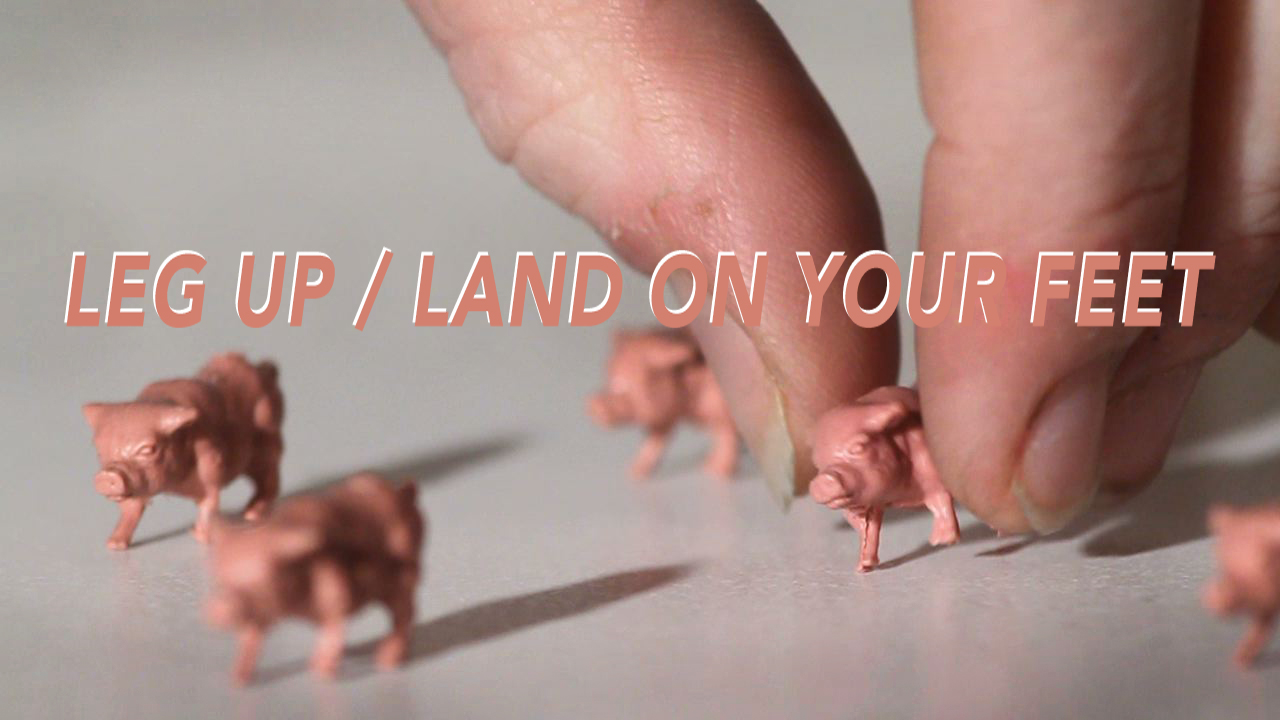
"There is power and truth in our lived experiences. There is power and truth in our shared stories. There is power and truth in hard data. Like magnets, these truths sometimes attract and sometimes repel each other, but pack them in a tight enough space and epic collisions seem inevitable..."
Project Summary:
Leg Up/Land On Your Feet is a multimedia artwork that will present viewers with an interactive experience that brings together physiological, narrative and quantitative methods of representing and understanding the world. The artwork focuses on our cultural constructions of success and failure. The recent financial crisis and its echoing foreclosures, bankruptcies and layoffs highlighted importance of risk, success and failure. These concerns continue to resonate in the culture as discussions of income inequality and the role of social versus individual responsibility.The financial crisis called into question many of our assumptions and cherished ideals about fairness, opportunity, hard work, risk, responsibility, failure and success. With Leg Up/Land on Your Feet I am creating an interactive event where audiences can explore and experience chance, failure and success on an experiential (individual), narrative (social), and statistical (abstract, formalized) level. There is power and truth in direct perception. There is power and truth in our stories, and there is power and truth in data. Leg Up/Land On Your Feet attempts to make a thoughtful and entertaining space where these powers converge and these truths collide.
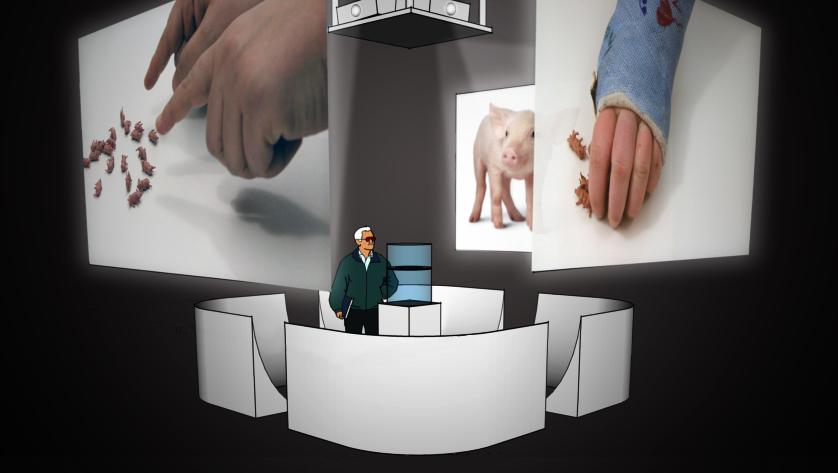
Rendering of Leg Up / Land on Your Feet
An important part of this project are video interviews in which people candidly share incidents of success and failure. These are coupled with footage of live piglets frolicking in an “infinity pen”, a video set that will also doubles as the viewing site of the completed artwork. I call this the “Actuarium” because it expresses many important associations including “actuarial,” “act” and “stadium.” The Actuarium is a place to consider the probabilities associated with life events and a place to confront and quantify risk and contingent outcomes. In the Actuarium participants will activate a computer controlled device similar to a lottery machine that will drop small plastic pigs to see if any land on their feet. The device will continue to figure the odds in real time which will be displayed alongside projected video and audio clips that are determined by the results of the successive piglet drops.
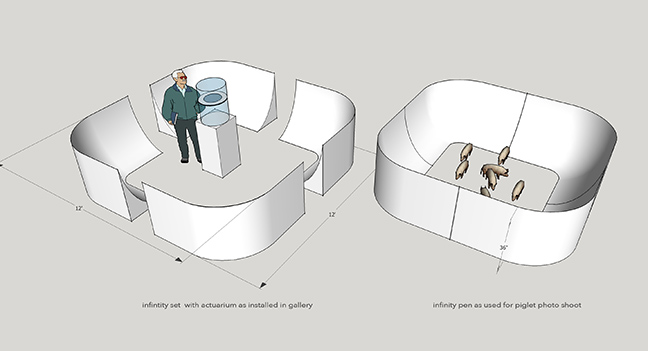
The Infinity Pen/Actuarium is a 3' X 8' X 8' structure with a 1' radius curve. It functions as the shooting backdrop for the piglet footage (a 1/8th scale version is also in the pig drop device) The same structure also doubles as the viewing/interaction site for the installation, the "Actuarium."
YOU CAN BE A VIDEO STAR!
(ANONYMOUSLY)
Okay, maybe not a star exactly, but please consider collaborating with me in a year long multimedia project Leg Up / Land on Your Feet. When completed this installation project will use video and participatory game play to allow viewers to experiment, experience, and think about fate, failure and success in new and provocative ways. Click here to participate online.
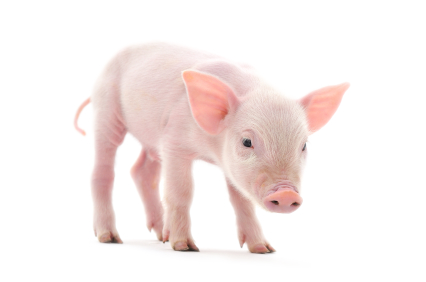
Piglets are pure possibility. There is innocence, playfulness, joy and vitality in their frolicking. This is why they make us smile & laugh. However, catastrophe and inevitability always loom perceptibly right below the surface. The exuberance of piglets' lives distracts us from what we know about the inevitability of their adult fates.
Description:
At the center of Leg Up/Land On Your Feet is the actuarium, a microprocessor-controlled device that automatically drops 23 small plastic pigs when activated by a viewer. Surrounding the actuarium is the “infinity set,” 4 units that that are somewhat smaller versions of an infinity curve backdrop commonly used in photography and video. Finally, there is an outermost ring of three 5’ X 9’ projection scrims that encompass both the actuarium and the infinity set. The video images that are projected onto these scrims and are visible from both sides. Viewers who enter the gallery space can either walk around the outside of the piece or can enter the work and approach the actuarium through a small breaks in the wall of the infinity set,
The actuarium gets its name from a combination of the words actuary and stadium. It has four basic functions: 1. It uses a five-lobed mechanical iris to drop 23 small plastic pigs every ten minutes or when activated by a viewer who pushes a button to release them. A tilt platform and forced air tube return the pigs back to the top of the unit after each release/sensing cycle. 2. A camera and visual object recognition software determine if any pigs have landed on their feet. 3. It calculates the ongoing statistical likelihood of this event based on past trials. This data is continually updated in real time after each release cycle, and is displayed on the central projection scrim alternating with other statistical information relating to success and failure within the culture. 4. After each release, the visual object recognition software uses the positions of the pigs to trigger the selection of two short video clips that are stored on a pair of video servers. Each sever has a selection of about seventy-five 2-4 minute clips that are shown on two of three projection scrims that surround the actuarium and the infinity set. These videos consist of personal stories of success, failure and its impact gleaned from individual interviews conducted at various sites around NW Ohio. Also featured are clips of actual piglets frolicking, fighting and sleeping. These sequences are shot in the infinity set, the same structure that the viewers stand in as they engage with the actuarium and view the videos.
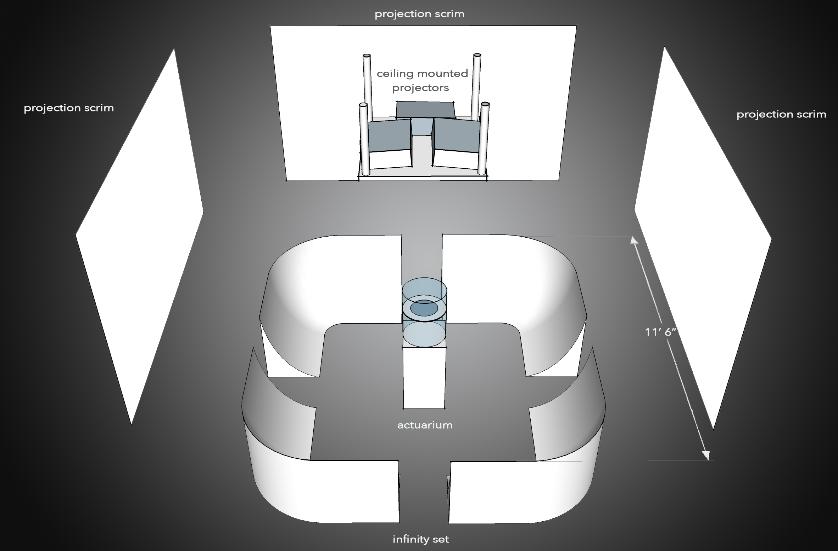
The infinity set takes its name from a background structure commonly used in photography called an infinity curve. The absence of a horizon line, shadows or any sharp corners creates the effect of a white, featureless background that extends to infinity. The infinity set in Leg Up/Land on Your Feet is three feet tall and twelve feet square. It is made up of four 5’ X 5’ units that when pushed together create a pen/photo set that holds 8 to 10 piglets for a video shoot that will result in footage that is viewed on the projection scrims. When installing Leg Up in the gallery, the infinity pen is separated to create breaks in the walls that allow viewers access to the actuarium. The infinity set and the photographic lights that are used to illuminate it are designed to give viewers the impression that they are walking in on a working photo shoot. In a sense they are. Leg Up is not a completed artwork simply awaiting their viewership. It requires their interaction to bring it to life. The infinity set and the photographic equipment signal the work’s provisionality. It announces to viewers that they are participating in a work-in-progress. This awareness of their active role in completing the work that they are experiencing is further enhanced by reinscription. The infinity set reinscribes the audience when they recognize that they are standing in the same set that they are watching in the piglet videos.

The videos in Leg Up/Land On Your Feet are stored on a pair of hard drives, each connected to a Videotel media player that serves up specific videos indexed by numeric code. The videos are projected onto 5’ X 9’ scrims that are suspended from the ceiling. Scrims are distinct from screens in that projected images are visible on both sides, (image 8.) Onto these scrims four categories of video imagery are projected, two of which are pre-produced, the piglets and the interviews, and two of which are live CCTV feeds. The first live feed is an overhead, wide-angle shot of the actuarium, infinity set, and participants taken from a CCTV camera located on one of the light booms. Viewers will intermittently see themselves reinscribed onto the central scrim. This shot will be mirrored by a similar overhead boom shot used to film the piglet sequences, (see below.) The second live feed alternates on the central scrim with the first. It displays a composited image of a close-up of the taken from inside the actuarium with the updated statistical information superimposed over it.
The pre–produced video sequences include images of live piglets cavorting, sleeping, eating, etc. in the infinity pen. The framing and camera angles for these piglet sequences will be quite varied but will include many moving shots that reveal the infinity pen set as part of a tracking shots that end by focusing in on the piglets scurrying about in it: slider shots that run along the side of the pen shooting down into it, dolly in shots that start outside of the pen and move for close-ups, and overhead boom shots that reveal the whole pen from the top and then swoop in tight on the piglets. I will also collect B-roll footage of the piglet wrangling into and out of set that may also find its way into the completed piece. In general the framing and camera work in all of the piglet footage will be guided by the aim of forging explicit visual connections between the live piglets, the miniature plastic piglets in the actuarium, and the viewers standing in the infinity set.
Perhaps the most important, and certainly the most interesting video footage in Leg Up/ Land on Your Feet are the personal interviews. These are conducted using a small portable video “booth” to capture quality audio of the interviewees’ stories and A & B-roll video of their hands, (images 8 & 9.) I begin the interviews by briefly explaining the project. I then give interviewees the plastic pigs, and encourage them to play with the pigs while we talk. I ask the participants to share several memorable, funny, embarrassing, and/or poignant stories of success or failure, large or small. Generally I have interviewees start by sharing their successes and move gradually towards discussions of failure, prompting them to think about specifics: their childhood; last week; at work; with your family; alone when nobody was watching. I try to keep these interviews conversational, letting participants elaborate on their thoughts about what counts as success and what counts as failure. There is no set time limit. Some interviews are as short as a minute or so, while a few have stretched for over 45 minutes. If the conversation lulls, I share some of my own stories of failure to help them feel comfortable and to make a meaningful connection. Another factor that eases participants’ self-consciousness is the fact that I only shoot their hands while we are talking. This was initially an aesthetic and conceptual decision, but has also proven to have the practical effect of making people feel comfortable in front of the camera. In the completed interview sequences I will edit out my voice prompts so that viewers can focus on the personal stories of the interviewees.
FAQs
Frequently Asked Questions
FAQ1: Why does the actuarium drop 23 plastic pigs?
Leg Up is a double entendre, a phrase that most often refers to offering assistance, but it is also a commonly used trope to indicate death. While there is much that we can control in our endeavors, chance, contingency and randomness play a surprisingly large role in our activities. Preliminary trials revealed that when released from a height of 20 inches, these plastic pigs will, on average, land on their feet 1 in every 127 attempts. One of the tenets of game theory is that in order to keep subjects engaged, a challenge must be neither too easy nor too difficult. Dropping 23 pigs at a time produces a state where a pig lands on its feet 1 time in every 6 releases. This has proven to be very consistent through 300 test trials of a 23-pig release. This is an success-to-failure ratio that will encourage viewers to spend time with the piece while also stressing the relative rareness of the event.
FAQ2: How will the actuarium know when a pig has landed on its feet?
The general principles of machine vision are fairly straightforward, however this is an instance in the build for this project where I need to enlist collaborators. There are several open source and commercial object recognition software solutions readily available. I plan on consulting with colleagues in computer science to assist me in determining the most appropriate software solution and to help identify a collaborator to customize the code. As a non-specialist it seems to me at this point that a top-mounted camera coupled with software heavily weighted to canny edge detection and exemplar matching would be able to distinguish the profile of a standing pig as seen from the top (a relatively smooth silhouette) from a field of pigs lying on their sides (fairly complex silhouettes) with pretty good accuracy.
FAQ3: The project sounds kinda cool, but is it art?
Leg Up presents general audiences with a more investigative, playful and interactive way of experiencing complex, often politicized social issues surrounding success and failure. It is an example of contemporary visual artistic practice sometimes referred to as “post-studio.” The term is meant to capture the fact that rather than being grounded in a particular art medium or tradition such as printmaking, painting or sculpture, post-studio artworks are research driven and take a form most appropriate to engaging and sharing the investigation with others. Leg Up makes use of some fairly advanced technology, but it is not an artwork about technology. For a more specialist art-savvy audience, Leg Up/Land On Your Feet is an investigation of the relationships between perception and representation and the ways that the context of display can be used to model our embedded and embodied interactions with the world. As such, it represents a departure from the dominant communication model of art production in favor of a metacognitive model. Leg Up/Land On Your Feet is an example of to a growing body of contemporary artwork that looks to integrate art, technology and data. Initiatives such as STEAM, championed by the Rhode Island School of Design promote an interdisciplinary approach to art making and education, and the burgeoning field of Digital Humanities is interested in the ways that technology can be brought to bear on traditional humanistic questions.